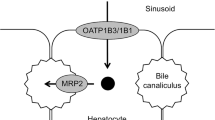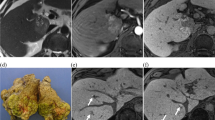Abstract
Objectives
To clarify the changes in organic anion-transporting polypeptide 8 (OATP8) expression and enhancement ratio on gadoxetic acid-enhanced MR imaging in hepatocellular nodules during multistep hepatocarcinogenesis.
Methods
In imaging analysis, we focused on 71 surgically resected hepatocellular carcinomas (well, moderately and poorly differentiated HCCs) and 1 dysplastic nodule (DN). We examined the enhancement ratio in the hepatobiliary phase of gadoxetic acid enhanced MR imaging [(1/postcontrast T1 value−1/precontrast T1 value)/(1/precontrast T1 value)], then analysed the correlation among the enhancement ratio, tumour differentiation grade and intensity of immunohistochemical OATP8 expression. In pathological analysis, we focused on surgically resected 190 hepatocellular nodules: low-grade DNs, high-grade DNs, early HCCs, well-differentiated, moderately differentiated and poorly differentiated HCCs, including cases without gadoxetic acid-enhanced MR imaging. We evaluated the correlation between the immunohistochemical OATP8 expression and the tumour differentiation grade.
Results
The enhancement ratio of HCCs decreased in accordance with the decline in tumour differentiation (P < 0.0001, R = 0.28) and with the decline of OATP8 expression (P < 0.0001, R = 0.81). The immunohistochemical OATP8 expression decreased from low-grade DNs to poorly differentiated HCCs (P < 0.0001, R = 0.15).
Conclusions
The immunohistochemical expression of OATP8 significantly decreases during multistep hepatocarcinogenesis, which may explain the decrease in enhancement ratio on gadoxetic acid-enhanced MR imaging.








Similar content being viewed by others
Abbreviations
- OATP:
-
organic anion transporting polypeptide
- MR:
-
magnetic resonance
- HCC:
-
hepatocellular carcinoma
- DN:
-
dysplasic nodule
- CT:
-
computed tomography
- SI:
-
signal intensity
- ROI:
-
region of interest
- HNF:
-
hepatocyte nuclear factor
- MRP:
-
multidrug resistance associated protein
References
Caldwell S, Park SH (2009) The epidemiology of hepatocellular cancer: from the perspectives of public health problem to tumor biology. J Gastroenterol 44(Suppl 19):96–101
Takayama T, Makuuchi M, Hirohashi S et al (1990) Malignant transformation of adenomatous hyperplasia to hepatocellular carcinoma. Lancet 336:1150–1153
Sakamoto M, Hirohashi S, Shimosato Y (1991) Early stages of multistep hepatocarcinogenesis: adenomatous hyperplasia and early hepatocellular carcinoma. Hum Pathol 22:172–178
Matsui O, Kadoya M, Kameyama T et al (1991) Benign and malignant nodules in cirrhotic livers: distinction based on blood supply. Radiology 178:493–497
Hayashi M, Matsui O, Ueda K et al (1999) Correlation between the blood supply and grade of malignancy of hepatocellular nodules associated with liver cirrhosis: evaluation by CT during intraarterial injection of contrast medium. Am J Roentgenol 172:969–976
Lencioni R, Piscaglia F, Bolondi L (2008) Contrast-enhanced ultrasound in the diagnosis of hepatocellular carcinoma. J Hepatol 48:848–857
Ohashi I, Hanafusa K, Yoshida T (1993) Small hepatocellular carcinomas: two-phase dynamic incremental CT in detection and evaluation. Radiology 189:851–855
Hecht EM, Holland AE, Israel GM et al (2006) Hepatocellular carcinoma in the cirrhotic liver: gadolinium-enhanced 3D T1-weighted MR imaging as a stand-alone sequence for diagnosis. Radiology 239:438–447
Vogl TJ, Kümmel S, Hammerstingl R et al (1996) Liver tumors: comparison of MR imaging with Gd-EOB-DTPA and Gd-DTPA. Radiology 200:59–67
Huppertz A, Balzer T, Blakeborough A et al (2004) European EOB Study Group. Improved detection of focal liver lesions at MR imaging: multicenter comparison of gadoxetic acid-enhanced MR images with intraoperative findings. Radiology 230:266–275
Schuhmann-Giampieri G, Schmitt-Willich H, Press WR, Negishi C, Weinmann HJ, Speck U (1992) Preclinical evaluation of Gd-EOB-DTPA as a contrast agent in MR imaging of the hepatobiliary system. Radiology 183:59–64
Bartolozzi C, Crocetti L, Lencioni R, Cioni D, Della Pina C, Campani D (2007) Biliary and reticuloendothelial impairment in hepatocarcinogenesis: the diagnostic role of tissue-specific MR contrast media. Eur Radiol 17:2519–2530
Huppertz A, Haraida S, Kraus A et al (2005) Enhancement of focal liver lesions at gadoxetic acid-enhanced MR imaging: correlation with histopathologic findings and spiral CT—initial observations. Radiology 234:468–478
Reimer P, Schneider G, Schima W (2004) Hepatobiliary contrast agents for contrast-enhanced MRI of the liver: properties, clinical development and applications. Eur Radiol 14:559–578
Saito K, Kotake F, Ito N et al (2005) Gd-EOB-DTPA enhanced MRI for hepatocellular carcinoma: quantitative evaluation of tumor enhancement in hepatobiliary phase. Magn Reson Med Sci 4:1–9
Kogita S, Imai Y, Okada M et al (2010) Gd-EOB-DTPA-enhanced magnetic resonance images of hepatocellular carcinoma: correlation with histological grading and portal blood flow. Eur Radiol 20:2405–2413
Kitao A, Zen Y, Matsui O et al (2010) Hepatocellular carcinoma: signal intensity at gadoxetic acid-enhanced MR imaging—correlation with molecular transporters and histopathologic features. Radiology 256:817–826
Narita M, Hatano E, Arizono S et al (2009) Expression of OATP1B3 determines uptake of Gd-EOB-DTPA in hepatocellular carcinoma. J Gastroenterol 44:793–798
Leonhardt M, Keiser M, Oswald S et al (2010) Hepatic uptake of the magnetic resonance imaging contrast agent Gd-EOB-DTPA: role of human organic anion transporters. Drug Metab Dispos 38:1024–1028
Ishimori Y, Kimura H, Uematsu H, Matsuda T, Itoh H (2003) Dynamic T1 estimation of brain tumors using double-echo dynamic MR imaging. J Magn Reson Imaging 18:113–120
Hayashi N, Miyati T, Koda W et al (2010) Quantitative evaluation of Gd-EOB-DTPA uptake in phantom study for liver MRI. Jpn J Radiol Technol 66:502–508, Japanese
Hirohashi S, Ishak KG, Kojiro M et al (2000) Hepatocellular carcinoma. In: Hamilton SR, Aaltonen LA (eds) Pathology and genetics of tumours of the digestive system. IARC Press, Lyon, pp 157–172
International Consensus Group for Hepatocellular Neoplasia (2009) Pathologic diagnosis of early hepatocellular carcinoma: a report of the international consensus group for hepatocellular neoplasia. Hepatology 49:658–664
Takano M, Otani Y, Tanda M, Kawami M, Nagai J, Yumoto R (2009) Paclitaxel-resistance conferred by altered expression of efflux and influx transporters for paclitaxel in the human hepatoma cell line, HepG2. Drug Metab Pharmacokinet 24:418–427
Vavricka SR, Jung D, Fried M, Grützner U, Meier PJ, Kullak-Ublick GA (2004) The human organic anion transporting polypeptide 8 (SLCO1B3) gene is transcriptionally repressed by hepatocyte nuclear factor 3beta in hepatocellular carcinoma. J Hepatol 40:212–218
Cui Y, König J, Nies AT et al (2003) Detection of the human organic anion transporters SLC21A6 (OATP2) and SLC21A8 (OATP8) in liver and hepatocellular carcinoma. Lab Invest 83:527–538
Hayashi Y, Wang W, Ninomiya T, Nagano H, Ohta K, Itoh H (1999) Liver enriched transcription factors and differentiation of hepatocellular carcinoma. Mol Pathol 52:19–24
Pascolo L, Petrovic S, Cupelli F et al (2001) Abc protein transport of MRI contrast agents in canalicular rat liver plasma vesicles and yeast vacuoles. Biochem Biophys Res Commun 282:60–66
Asayama Y, Tajima T, Nishie A et al (2010) Uptake of Gd-EOB-DTPA by hepatocellular carcinoma: radiologic-pathologic correlation with special reference to bile production. Eur J Radiol. doi:10.1016/j.ejrad.2010.10.032
Acknowledgements
This work was supported in part by a Grant-in-Aid for Japanese Scientific Research (21591549) from the Ministry of Education, Culture, Sports, Science and Technology and by Health and Labor Sciences Research Grants for “Development of novel molecular markers and imaging modalities for earlier diagnosis of hepatocellular carcinoma”.
Author information
Authors and Affiliations
Corresponding author
Rights and permissions
About this article
Cite this article
Kitao, A., Matsui, O., Yoneda, N. et al. The uptake transporter OATP8 expression decreases during multistep hepatocarcinogenesis: correlation with gadoxetic acid enhanced MR imaging. Eur Radiol 21, 2056–2066 (2011). https://doi.org/10.1007/s00330-011-2165-8
Received:
Revised:
Accepted:
Published:
Issue Date:
DOI: https://doi.org/10.1007/s00330-011-2165-8




